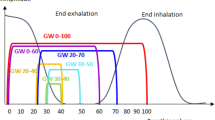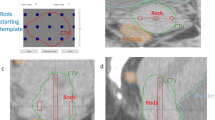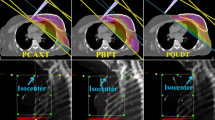Abstract
Aim
Three-dimensional inverse treatment planning with modulated beams was applied for dosimetric optimization of a lengthy (22 cm) and complex (concave-convex) shaped planning target volume (PTV) in the cervical and upper mediastinal regions.
Material and Method
The planning was done for 9 coplanar beams spaced evenly at 40° intervals. Properties of 15 MV photons from a linear accelerator were simulated. The optimization of the fluence modulation profiles for each beam was based on a definition of the desired/permitted relative dose levels in the PTV and organs at risk, and a definition of the strengths of the constraints to achieve these objectives.
Results
An adequate dose delivery to the PTV and protection of the spinal cord are completely achievable. The dose delivered to the lungs is clinically acceptable with respect to the risk of radiation-induced pneumonitis. For reasons of physics, no further decrease in the radiation burden on the lungs can be attained with X-rays without compromising the PTV coverage. The radiation burden on some critical part of normal tissues was effectively reduced by application of a dummy organ at risk.
Conclusion
The inverse planning is an effective method for conformal radiotherapy of large tumors as well. However, the power of the technique is insufficient when the tolerance dose of the neighbouring normal tissue is too low and its volume effect is high. Although requiring further operator interactions, introduction of dummy organs at risk may be of help in reducing the radiation burden on normal tissues.
Zusammenfassung
Ziel
Die dreidimensionale inverse Bestrahlungsplanung mit einem intensitätsmodulierten Strahl wurde zur Optimierung der Dosisverteilung eingesetzt. Dieses Verfahren wurde bei einem länglichen (22 cm) und komplex (konvex-konkav) geformten Planungszielvolumen (PTV) im Halsbereich und im oberen Mediastinum angewandt.
Material und Methode
Die Bestrahlungsplanung erfolgte für neun koplanare Felder, die gleichmäßig im 40°-Winkelabstand angeordnet waren. Zur Simulation wurden 15-MV-Photonen eines Linearbeschleunigers angenommen. Die Optimierung der Modulationsprofile für jedes Feld erfolgte aufgrund der Vorgabe der gewünschten bzw. erlaubten Dosis im Planungszielvolumen und den Risikoorganen sowie der Definition der Randbedingungen, um diese Ziele zu erreichen.
Ergebnisse
Es ist möglich, eine adäquate Dosis im PTV bei ausreichendem Schutz des Rückenmarks zu applizieren. Die Bestrahlungsdosis im Bereich der Lunge ist klinisch annehmbar unter Berücksichtigung des Risikos einer radiogenen Pneumonitis. Aus physikalischen Gründen kann keine weitere Reduktion der Strahlenbelastung der Lungen erreicht werden, ohne daß Kompromisse hinsichtlich der Erfassung des PTV zu akzeptieren sind. Die Strahlenbelastung einiger empfindlicher Teile des Normalgewebes konnte durch die Anwendung eines “dummy organ at risk” deutlich reduziert werden.
Schlußfolgerung
Die inverse Bestrahlungsplanung ist eine wirkungsvolle Methode zur konformierenden Bestrahlungsplanung auch großvolumiger Tumoren. Jedoch sind die Ergebnisse dieser Technik unbefriedigend, wenn die Toleranzdosis der benachbarten Organe zu niedrig und der Volumeneffekt groß ist. Die Einführung von “dummy organ at risk” könnte hilfreich sein, um die Strahlenbelastung des Normalgewebes zu reduzieren, auch wenn damit die Bestrahlungsplanung aufwendiger wird.
Similar content being viewed by others
References
Bendl, R., J. Pross, A. Hoess, M. A. Keller, K. Preiser, W. Schlegel: VIRTUOS — a program for VIRTUal radiOtherapy Simulation and verification. In: Hounsell, A. R., J. M. Wilkinson, P. C. Williams (eds.): Proc. 11th Int. Conference on the Use of Computers in Radiation Therapy, Manchester 1994, p. 226–227.
Bortfeld, T., A. L. Boyer, W. Schlegel, D. L. Kahler, T. J. Waldron: Realization and verification of three-dimensional conformal radiotherapy with modulated fields. Int. J. Radiat. Oncol. Biol. Phys. 30 (1994), 899–908.
Bortfeld, T., J. Bürkelbach, R. Boesecke, W. Schlegel: Methods of image reconstruction from projections applied to conformation radiotherapy. Phys. Med. Biol. 35 (1990), 1423–1434.
Bortfeld, T. R., D. L. Kahler, T. J. Waldron, A. L. Boyer: X-ray field compensation with multileaf collimators. Int. J. Radiat. Oncol. Biol. Phys. 28 (1994), 723–730.
Bortfeld, T., W. Schlegel, B. Rhein: Decomposition of pencil beam kernels for fast dose calculations in three-dimensional treatment planning. Med. Phys. 20 (1993), 311–318.
Boyer, A. L., T. R. Bortfeld, D. L. Kahler, T. J. Waldron: MLC modulation of X-ray beams in discrete steps. In: Hounsell, A. R., J. M. Wilkinson, P. C. Williams (eds.): Proc. 11th Int. Conference on the Use of Computers in Radiation Therapy, Manchester 1994, p. 178–179.
Boyer, A. L., G. E. Desobry, N. H. Wells: Potential and limitations of invariant kernel conformal therapy. Med. Phys. 18 (1991), 703–712.
Brahme, A.: Optimization of stationary and moving beam radiation therapy techniques. Radiother. Oncol. 12 (1988), 129–140.
Brahme, A.: Optimization of radiation therapy and the development of multileaf collimation. Int. J. Radiat. Oncol. Biol. Phys. 25 (1993), 373–375.
Brahme, A., J.-E. Roos, I. Lax: Solution of an integral equation in encountered rotation therapy. Phys. Med. Biol. 27 (1982), 1221–1229.
Burman, C., G. J. Kutcher, B. Emami, M. Goitein: Fitting of normal tissue tolerance data to an analytical function. Int. J. Radiat. Oncol. Biol. Phys. 21 (1991), 123–135.
Carol, M. P.: Integrated 3-D conformal multivane intensity modulation delivery system for radiotherapy. In: Hounsell, A. R., J. M. Wilkinson, P. C. Williams (eds.): Proc. 11th Int. Conference on the Use of Computers in Radiation Therapy, Manchester 1994, p. 172–173.
Clouse, M. E., S. Wallace: Lymphatic imaging. In: Harris, J. H. Jr. (ed.): Golden’s diagnostic radiology, 2nd ed. Williams and Wilkins, Baltimore-London-Los Angeles-Sydney 1985.
Convery, D. J., M. E. Rosenbloom: The generation of intensity-modulated fields for conformal radiotherapy by dynamic collimation. Phys. Med. Biol. 37 (1992), 1359–1374.
Emami, B., J. Lyman, A. Brown, L. Coia, M. Goitein, J. E. Munzenrider, B. Shank, L. J. Solin, M. Wesson: Tolerance of normal tissue to therapeutic irradiation. Int. J. Radiat. Oncol. Biol. Phys. 21 (1991), 109–122.
Holmes, T. W., T. R. Mackie, P. J. Reckwerdt, J. O. Deasy: A prototype inverse treatment planning algorithm for tomotherapy. In: Hounsell, A. R., J. M. Wilkinson, P. C. Williams (eds.): Proc. 11th Int. Conference on the Use of Computers in Radiation Therapy, Manchester 1994, p. 62–63.
ICRU Report 50: Prescribing, recording and reporting photon beam therapy. ICRU, Washington DC 1993.
Mackie, T. R., T. W. Holmes, S. Swerdloff, P. Reckwerdt, J. O. Deasy, J. Yang, B. Paliwal, K. J. Kinsella: Tomotherapy: a new concept for the delivery of dynamic conformal radiotherapy. Med. Phys. 20 (1993), 1709–1719.
Mohan, R., X. Wang, A. Jackson, T. Bortfeld, A. Boyer, G. J. Kutcher, S. A. Leibel, Z. Fuks, C. C. Ling: The potential and limitations of the inverse radiotherapy technique. Radiother. Oncol. 32 (1994), 232–248.
Oldham, M., S. Webb: Inverse planning and the optimization of radiotherapy plans by simulated annealing incorporating dual weighting. In: Hounsell, A. R., J. M. Wilkinson, P. C. Williams (eds.): Proc. 11th Int. Conference on the Use of Computers in Radiation Therapy, Manchester 1994, p. 60–61.
Pross, J., R. Bendl, W. Schlegel: TOMAS, a TOol for MAnual Segmentation based on multiple image data sets. In: Hounsell, A. R., J. M. Wilkinson, P. C. Williams (eds.): Proc. 11th Int. Conference on the Use of Computers in Radiation Therapy, Manchester 1994, p. 192–193.
Rouvière, H.: Anatomie des lymphatiques de l’homme. Masson and Cie., Paris 1932.
Rusznyák, I., M. Földi, G. Szabó: Lymphatics and lymph circulation. Pergamon Press Ltd., New York-Oxford-London-Paris 1960.
Schlegel, W., R. Boesecke, B. Bauer, K. Alandt, W. J. Lorenz: Dynamic therapy planning. In: Bruinvis, I. A. D., P. H. van der Giessen, H. J. van Kleffens, F. W. Wittkamper (eds.): The use of computers in radiation therapy. Elsevier Sci. Publ., Scheveningen, North Holland 1987, p. 361–365.
Schlegel, W., H. Scharfenberg, R. Bader, G. Hartmann, K. Schnabel, W. J. Lorenz: Computer algorithms for calculation of isodose distributions from CT matrices. Brit. J. Radiol., Suppl. 15 (1981), 118–121.
Stein, J., T. Bortfeld, B. Dorschel, W. Schlegel: X-ray intensity modulation by dynamic multileaf collimation. In: Hounsell, A. R., J. M. Wilkinson, P. C. Williams (eds.): Proc. 11th Int. Conference on the Use of Computers in Radiation Therapy, Manchester 1994, p. 174–175.
Webb, S.: Optimization by simulated annealing of three-dimensional conformal treatment planning for radiation fields defined by a multileaf collimator. Phys. Med. Biol. 36 (1991), 1201–1226.
Webb, S.: Optimization by simulated annealing of three-dimensional, conformal treatment planning for radiation fields defined by a multileaf collimator: II. Inclusion of the two-dimensional modulation of the X-ray intensity. Phys. Med. Biol. 37 (1992), 1689–1704.
Webb, S.: The physics of three-dimensional radiation therapy. IOP Publishing Ltd., Bristol 1993.
Author information
Authors and Affiliations
Corresponding author
Rights and permissions
About this article
Cite this article
Ésik, O., Bortfeld, T., Bendl, R. et al. Inverse radiotherapy planning for a concave-convex PTV in cervical and upper mediastinal regions. Strahlenther. Onkol. 173, 193–200 (1997). https://doi.org/10.1007/BF03039288
Received:
Accepted:
Issue Date:
DOI: https://doi.org/10.1007/BF03039288




